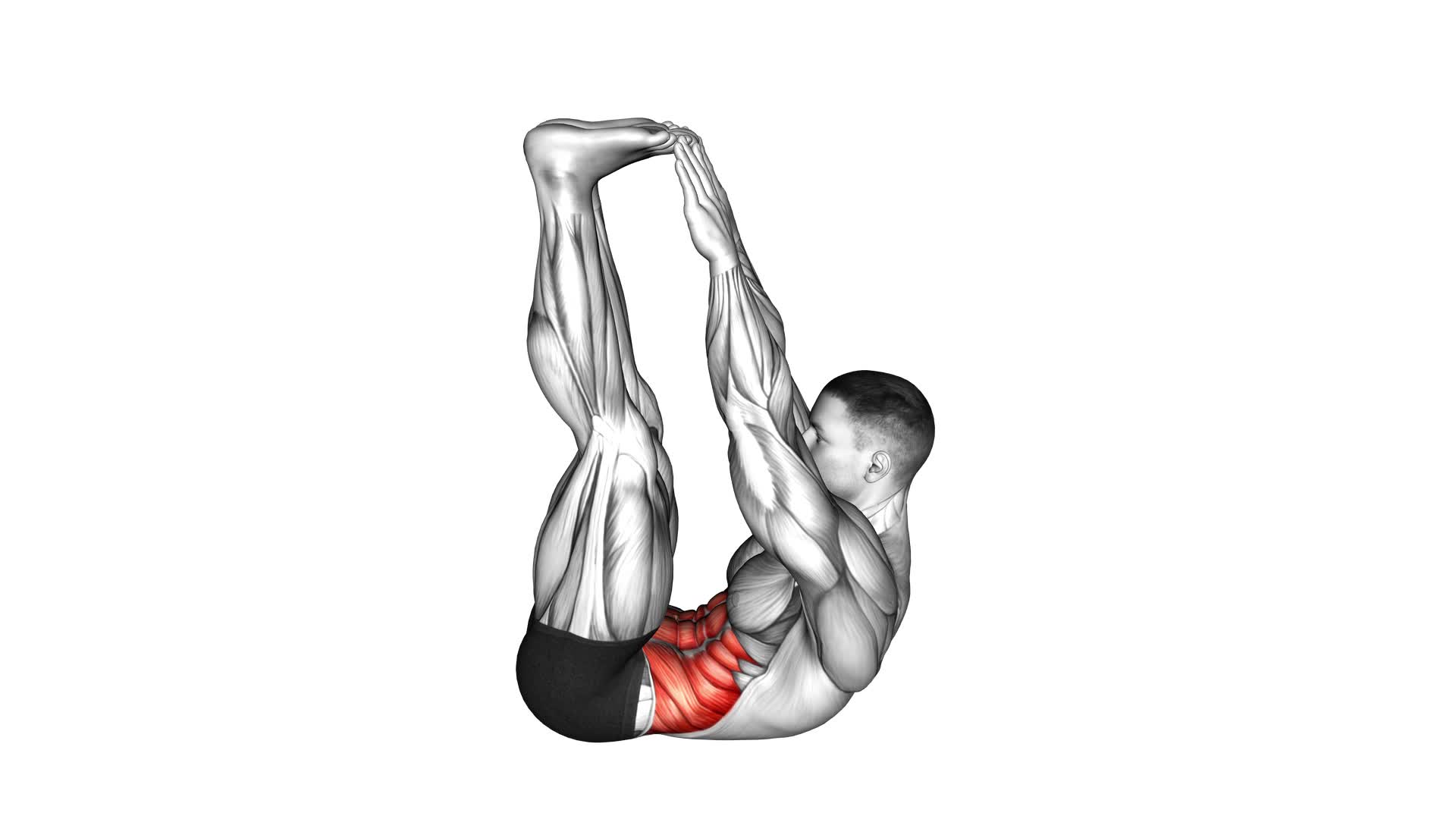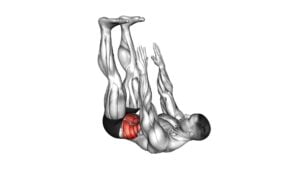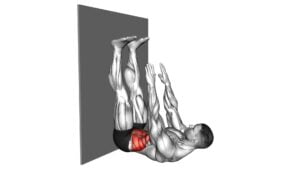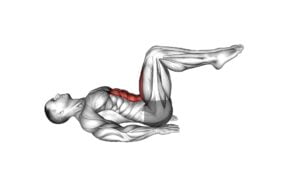Lying Toe Touch – Video Exercise Guide & Tips

Are you looking for a way to improve your flexibility and strengthen your core? Look no further than the lying toe touch exercise!
Watch This Exercise Video
In this video exercise guide, we'll show you the proper form and technique to get the most out of this exercise. Whether you're a beginner or an advanced fitness enthusiast, we've got modifications and variations to suit your level.
Say goodbye to common mistakes and hello to a stronger, more flexible you!
Key Takeaways
- The lying toe touch exercise can help increase flexibility in the hamstrings and lower back.
- Proper form and control are important in this exercise to prevent injury and maximize the stretch.
- Beginners should focus on stretching the hamstrings rather than touching their toes and can modify the exercise with assistance or by bending their knees slightly.
- Advanced variations of the lying toe touch include single-leg toe touch, medicine ball toe touch, Swiss ball toe touch, weighted toe touch, and toe touch with leg raise.
Benefits of the Lying Toe Touch
You'll experience increased flexibility and improved hamstring strength with the lying toe touch exercise. This exercise primarily targets your hamstrings, but it also engages your core muscles, leading to improved core strength. By incorporating the lying toe touch into your workout routine, you can reap numerous benefits for your body.
Improved flexibility is one of the key advantages of the lying toe touch exercise. As you reach towards your toes, you're stretching your hamstrings and lower back, promoting greater flexibility in these areas. Over time, this increased flexibility can enhance your overall range of motion and help prevent injuries.
Additionally, the lying toe touch exercise also strengthens your hamstrings. By engaging these muscles, you can improve their strength and power. Strong hamstrings are essential for various daily activities, such as walking, running, and jumping. They also play a crucial role in stabilizing the knee joint, which can contribute to better overall knee health.
Moreover, the lying toe touch exercise engages your core muscles, including your abdominals and obliques. These muscles work together to provide stability and support for your spine. Strengthening your core can enhance your posture, balance, and overall functional movement.
Proper Form and Technique
To perform the lying toe touch exercise correctly, follow these steps.
- Lie on your back with your legs extended straight up towards the ceiling.
- Keep your lower back pressed against the floor and engage your core muscles.
- Slowly lower your legs towards the floor while maintaining control.
- Only go as far as you can without lifting your lower back off the floor.
- Once you feel a stretch in your hamstrings, pause for a moment.
- Return to the starting position by lifting your legs back up towards the ceiling.
- Repeat for the desired number of repetitions.
Now, let's address some common misconceptions about the lying toe touch exercise.
One misconception is that you need to touch your toes with your hands. However, the goal of this exercise is to stretch your hamstrings, not necessarily touch your toes. So, focus on maintaining proper form and control rather than reaching a specific point with your hands.
In terms of injury prevention techniques, it's important to warm up before performing this exercise.
- Warm up your muscles with some light cardio and dynamic stretching.
- Increase blood flow and prepare your body for the movement.
Additionally, listen to your body and only go as far as you can without experiencing pain or discomfort.
If you feel any strain in your lower back, modify the exercise by bending your knees slightly or reducing the range of motion. Remember, proper form and technique are key to preventing injuries and maximizing the benefits of the lying toe touch exercise.
Modifications for Beginners
If you're new to the lying toe touch exercise, there are a few modifications you can make to ease into the movement and build strength in your hamstrings. As a beginner, it's important to start with proper stretching techniques before attempting the full exercise.
One modification you can try is bending your knees slightly to reduce the strain on your hamstrings. This will allow you to focus on the movement and gradually increase your flexibility over time.
Another modification is using a resistance band or towel to assist you in reaching your toes. This will provide extra support and help you achieve a deeper stretch without overexerting yourself. Remember to listen to your body and only go as far as you feel comfortable.
As you become more familiar with the exercise and your flexibility improves, you can gradually decrease the assistance from the band or towel. These modifications will help you gradually build strength and flexibility in your hamstrings, setting a solid foundation for more advanced variations and progressions.
Advanced Variations and Progressions
To progress in the lying toe touch exercise, incorporate advanced variations that challenge your flexibility and strength. Here are some advanced modifications and flexibility exercises to take your workout to the next level:
- Single-leg Lying Toe Touch: Perform the exercise with one leg extended in the air, while the other leg remains bent. This variation increases the demand on your core and requires greater balance and stability.
- Medicine Ball Lying Toe Touch: Hold a medicine ball in your hands as you lift your legs and reach for your toes. The added weight challenges your upper body and increases the intensity of the exercise.
- Swiss Ball Lying Toe Touch: Place a Swiss ball between your feet and perform the exercise while balancing on the ball. This variation engages your core even more and improves stability and coordination.
- Weighted Lying Toe Touch: Hold a dumbbell or kettlebell in your hands as you reach for your toes. The added resistance increases the difficulty of the exercise and further strengthens your muscles.
- Lying Toe Touch with Leg Raise: Lift both legs off the ground as you reach for your toes, engaging your lower abs and hip flexors. This modification targets your lower abdominal muscles and improves overall core strength.
By incorporating these advanced variations and flexibility exercises, you can continue to challenge yourself and make progress in your fitness journey.
Now, let's move on to the next section and discuss common mistakes to avoid.
Common Mistakes to Avoid
To avoid common mistakes while performing the lying toe touch exercise, be mindful of your form and maintain proper alignment throughout the movement.
One common mistake is rounding your back instead of keeping it flat on the ground. This not only reduces the effectiveness of the stretch but also puts unnecessary strain on your lower back.
Another mistake is using momentum to lift your legs instead of engaging your core muscles. By relying on momentum, you aren't effectively targeting the muscles that this exercise is intended to stretch.
Additionally, avoid locking your knees during the movement. Locking your knees can lead to hyperextension and potential injury. Instead, keep a slight bend in your knees to maintain stability and control.
Lastly, remember to breathe throughout the exercise. Holding your breath can cause tension in your muscles, making it harder to achieve a deep stretch.
Tips for Maximizing Your Stretch and Strength
To maximize your stretch and strength during the lying toe touch exercise, it's important to focus on proper form techniques. This includes keeping your back straight, engaging your core muscles, and reaching towards your toes with control.
Additionally, it's recommended to hold the stretch for at least 15-30 seconds to allow your muscles to fully elongate.
To further enhance your flexibility, incorporate strengthening exercises such as leg raises and hamstring curls into your routine.
Proper Form Techniques
Maximize your stretch and strength with these essential tips for proper form techniques:
- Maintain proper alignment: Keep your back straight and engage your core muscles to prevent strain on your lower back.
- Relax your neck and shoulders: Avoid tension in these areas by consciously releasing any tightness.
Control your breathing: Inhale deeply before starting the stretch and exhale as you reach for your toes, allowing your body to relax into the movement.
Avoid common mistakes: Don't force the stretch or bounce, as this can lead to injury. Instead, focus on gradually increasing your range of motion.
Pay attention to stretching duration: Aim to hold each stretch for 20-30 seconds, allowing your muscles time to relax and lengthen.
Stretching Duration Recommendations
By following the tips for proper form techniques discussed earlier, you can now delve into the recommendations for stretching duration to maximize your stretch and strength.
When it comes to stretching, it's important to find the right balance between holding the stretch for long enough to be effective, but not so long that it causes discomfort or injury. Generally, it's recommended to hold each stretch for 15 to 30 seconds, and repeat the stretch 2 to 4 times on each side.
It's also beneficial to incorporate dynamic stretching techniques, such as leg swings or arm circles, into your warm-up exercises. These movements help to increase blood flow and prepare your muscles for the upcoming stretches.
Now that you know the recommended stretching duration, let's move on to the next section about strengthening exercises for flexibility.
Strengthening Exercises for Flexibility
To enhance your stretch and increase strength, incorporate strengthening exercises into your routine. These exercises can help improve your flexibility and maximize the benefits of your stretching routine.
Here are some yoga poses and Pilates exercises that can help you achieve this:
- Downward Dog: This pose stretches and strengthens your entire body, especially your hamstrings and calves.
- Plank: Holding a plank position engages your core muscles, promoting stability and strength throughout your body.
- Warrior II: This standing pose targets your legs, hips, and shoulders, improving flexibility and strength in these areas.
- Pilates Hundred: This exercise strengthens your core, arms, and legs, while also improving your breathing and circulation.
- Bridge Pose: This pose activates your glutes and hamstrings, increasing lower body strength and flexibility.
Incorporating these exercises into your routine won't only enhance your stretching, but also help you build strength and improve overall flexibility.
Frequently Asked Questions
How Many Sets and Repetitions Should I Do When Performing the Lying Toe Touch Exercise?
When performing the lying toe touch exercise, it's important to consider the number of sets and repetitions.
To determine the right amount for you, start with a moderate number, like three sets of 10 repetitions.
As you become more comfortable and stronger, you can increase the intensity by adding more sets or reps.
Can I Perform the Lying Toe Touch Exercise if I Have a History of Lower Back Pain?
If you have a history of lower back pain, it's important to be cautious when performing the lying toe touch exercise. This exercise puts strain on the lower back and may worsen your pain. Instead, focus on gentle lower back stretches that can help alleviate discomfort.
There are also alternative exercises that target the same muscles without putting excessive stress on your back. Consult with a healthcare professional for personalized guidance.
Should I Perform the Lying Toe Touch Exercise Before or After My Workout?
Before or after your workout, performing the lying toe touch exercise can be beneficial.
As a pre-workout warm-up, it helps stretch your hamstrings and lower back, increasing flexibility and reducing the risk of injury.
This exercise also improves core strength and stability.
However, it's important to listen to your body and avoid any pain or discomfort.
If you have a history of lower back pain, consult with a healthcare professional before incorporating this exercise into your routine.
Are There Any Specific Breathing Techniques I Should Follow While Doing the Lying Toe Touch Exercise?
When performing the lying toe touch exercise, it's important to focus on your breathing techniques. Take a deep breath in as you lift your legs and reach for your toes, and exhale as you lower them back down. This will help you engage your core and maximize the effectiveness of the exercise.
Can I Use Any Equipment or Props to Enhance the Effectiveness of the Lying Toe Touch Exercise?
To enhance the effectiveness of the lying toe touch exercise, you can incorporate various equipment and props. These can include a yoga strap, exercise ball, or foam roller.
Using a yoga strap can help you reach further and increase flexibility.
The exercise ball can provide stability and support for your back.
And the foam roller can assist in targeting specific muscles and improving balance.
These variations and modifications can take your workout to the next level.
Conclusion
In conclusion, the lying toe touch is a beneficial exercise for improving flexibility and strength in the lower body. By following proper form and technique, beginners can gradually build their way up to advanced variations and progressions.
It's important to avoid common mistakes and maximize the stretch and strength by incorporating the provided tips. Incorporating the lying toe touch into your exercise routine can help you achieve your fitness goals.

Author
Years ago, the spark of my life’s passion ignited in my mind the moment I stepped into the local gym for the first time. The inaugural bead of perspiration, the initial endeavor, the very first surge of endorphins, and a sense of pride that washed over me post-workout marked the beginning of my deep-seated interest in strength sports, fitness, and sports nutrition. This very curiosity blossomed rapidly into a profound fascination, propelling me to earn a Master’s degree in Physical Education from the Academy of Physical Education in Krakow, followed by a Sports Manager diploma from the Jagiellonian University. My journey of growth led me to gain more specialized qualifications, such as being a certified personal trainer with a focus on sports dietetics, a lifeguard, and an instructor for wellness and corrective gymnastics. Theoretical knowledge paired seamlessly with practical experience, reinforcing my belief that the transformation of individuals under my guidance was also a reflection of my personal growth. This belief holds true even today. Each day, I strive to push the boundaries and explore new realms. These realms gently elevate me to greater heights. The unique combination of passion for my field and the continuous quest for growth fuels my drive to break new ground.







